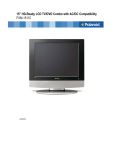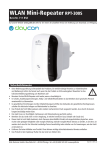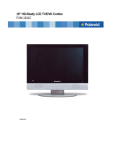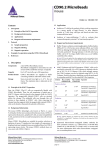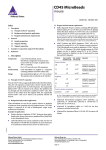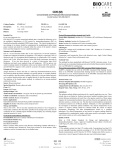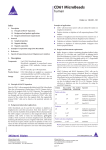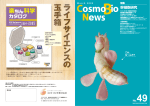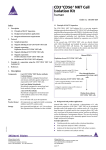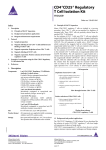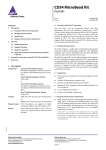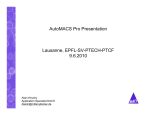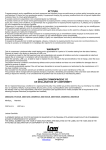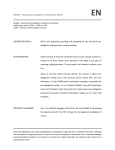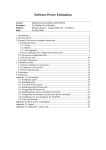Download CD49b (DX5) MicroBeads
Transcript
CD49b (DX5) MicroBeads mouse Order No. 130-052-501 Magnetic cell sorting Index 1.3 Reagent and instrument requirements 1. Description ● 1.1 Principle of MACS® separation Buffer (degassed): Prepare a solution containing PBS (phosphate buffered saline) pH 7.2, 0.5% BSA (bovine serum albumin) and 2 mM EDTA by diluting MACS BSA Stock Solution (# 130-091-376) 1:20 in autoMACS™ Rinsing Solution (# 130-091-222). Keep buffer cold (4−8 °C). ▲ Note: EDTA can be replaced by other supplements such as anticoagulant citrate dextrose formula-A (ACD-A) or citrate phosphate dextrose (CPD). BSA can be replaced by other proteins such as gelatine, mouse serum or fetal calf serum. Buffers or media containing Ca2+ or Mg2+ are not recommended for use. ● MACS Columns and MACS Separators: CD49b+ cells can be enriched by using MS, LS or XS Columns (positive selection). CD49b (DX5) MicroBeads can be used for depletion of CD49b+ cells on LD, CS or D Columns. Cells which strongly express CD49b can also be depleted using MS, LS or XS Columns. Positive selection or depletion can also be performed by using the autoMACS Separator. 1.2 Background and product applications 1.3 Reagent and instrument requirements 2. Protocol 2.1 Sample preparation 2.2 Magnetic labeling 2.3 Magnetic separation 3. Example of a separation using CD49b (DX5) MicroBeads 4. References 1. Description Components 2 m L C D 4 9 b ( DX 5 ) Mi c ro B e ads , mous e : MicroBeads conjugated to monoclonal anti-mouse NK cell (DX5; isotype: rat IgM; clone: DX5) antibody. Size For 2×109 total cells, up to 200 separations. Product format CD49b (DX5) MicroBeads are supplied as a suspension containing stabilizer and 0.05% sodium azide. Storage Store protected from light at 4−8 °C. Do not freeze. The expiration date is indicated on the vial label. 1.1 Principle of MACS® separation First the CD49b+ cells are magnetically labeled with CD49b (DX5) MicroBeads. Then the cell suspension is loaded onto a MACS® Column which is placed in the magnetic field of a MACS Separator. The magnetically labeled CD49b+ cells are retained on the column. The unlabeled cells run through and this cell fraction is depleted of CD49b+ cells. After removal of the column from the magnetic field, the magnetically retained NK cells can be eluted as the positively selected cell fraction. Column 140-000-103.03 ● Separator Positive selection 2×108 MS 107 MiniMACS, OctoMACS, VarioMACS, SuperMACS LS 108 2×109 MidiMACS, QuadroMACS, VarioMACS, SuperMACS XS 109 2×1010 SuperMACS Depletion 5×108 LD 108 CS 2×108 D 109 MidiMACS, QuadroMACS, VarioMACS, SuperMACS VarioMACS, SuperMACS SuperMACS Positive selection or depletion autoMACS 2×108 4×109 autoMACS ▲ Note: Column adapters are required to insert certain columns into VarioMACS™ 1.2 Background and product applications Mouse CD49b (DX5) MicroBeads were developed for the isolation of mouse NK cells from single-cell suspensions of lymphoid and nonlymphoid tissue, as well as from peripheral blood or body fluids. The MicroBeads were formerly called Anti-NK Cell (DX5) MicroBeads. CD49b is expressed on NK cells and a small population of T cells (CD4+CD3+TCRαβ+). These cells can be depleted prior to NK cell enrichment by using CD90 (Thy1.2) MicroBeads or CD5 MicroBeads. CD49b is less mouse strain-specific than other NK cell markers (e.g. NK1.1) and is expressed by the most common inbred mouse strains. Examples of applications ● Isolated NK cells were used for the evaluation of NK cell cytotoxicity in normal and immunodeficient mice in vitro1 or after adoptive transfer in vivo.2 max. number max. number of labeled cells of total cells Separator or SuperMACS™ Separator. For details, see MACS Separator data sheets. ● (Optional) Fluorochrome-conjugated CD49b antibodies, e.g. CD49b (DX5)-FITC (# 130-091-814), CD49b (DX5)-PE (# 130-091-816) or CD49b (DX5)-APC (# 130-091-813). ● (Optional) PI (propidium iodide) or 7-AAD for flow cytometric exclusion of dead cells. ● (Optional) Pre-Separation Filters (# 130-041-407) to remove cell clumps. Isolation of NK cells to study their role in experimental mouse models of immune-mediated liver injury3 or chronic infection with parasitic helminths4. www.miltenyibiotec.com Miltenyi Biotec GmbH Friedrich-Ebert-Str. 68 51429 Bergisch Gladbach, Germany Phone +49-2204-8306-0 Fax +49-2204-85197 Miltenyi Biotec Inc. 2303 Lindbergh Street, Auburn, CA 95602, USA Phone 800 FOR MACS, 530 888-8871 Fax 530 888-8925 page 1/3 Order No. 130-052-501 2. Protocol 2.3 Magnetic separation 2.1 Sample preparation Prepare a single-cell suspension from lymphoid organs, non-lymphoid tissue or peripheral blood using standard methods (see "General Protocols" in the User Manuals or visit www.miltenyibiotec.com). ▲ Dead cells may bind non-specifically to MACS MicroBeads. In case of high numbers of dead cells we recommend to remove dead cells by density gradient centrifugation or using the Dead Cell Removal Kit (# 130-090-101). 2.2 Magnetic labeling ▲ Work fast, keep cells cold, and use pre-cooled solutions. This will prevent capping of antibodies on the cell surface and non-specific cell labeling. ▲ Volumes for magnetic labeling given below are for up to 107 total cells. When working with fewer than 107 cells, use the same volumes as indicated. When working with higher cell numbers, scale up all reagent volumes and total volumes accordingly (e.g. for 2×107 total cells, use twice the volume of all indicated reagent volumes and total volumes). ▲ For optimal performance it is important to obtain a singlecell suspension before magnetic separation. Pass cells through 30 µm nylon mesh (Pre-Separation Filters # 130-041-407) to remove cell clumps which may clog the column. 1. Determine cell number. 2. Centrifuge cell suspension at 300×g for 10 minutes. Pipette off supernatant completely. 3. Resuspend cell pellet in 90 µL of buffer per 107 total cells. 4. Add 10 µL of CD49b (DX5) MicroBeads per 107 total cells. 5. Mix well and incubate for 15 minutes at 4−8 °C. ▲ Note: Working on ice may require increased incubation times. Higher temperatures and/or longer incubation times lead to non-specific cell labeling. 6. (Optional) Add a fluorochrome-conjugated CD49b antibody according to manufacturer's recommendation, and incubate for 5 minutes at 4−8 °C. 7. Wash cells by adding 1−2 mL of buffer per 107 cells and centrifuge at 300×g for 10 minutes. Pipette off supernatant completely. 8. Resuspend up to 108 cells in 500 µL of buffer. ▲ Note: For higher cell numbers, scale up buffer volume accordingly. ▲ Note: For depletion with LD Columns, resuspend cell pellet in 500 µL of buffer for up to 1.25×108 cells. 9. Proceed to magnetic separation (2.3). ▲ Choose an appropriate MACS Column and MACS Separator according to the number of total cells and the number of CD49b+ cells (see table in section 1.3). Magnetic separation with MS or LS Columns 1. Place column in the magnetic field of a suitable MACS Separator (see "Column data sheets"). 2. Prepare column by rinsing with appropriate amount of buffer: MS: 500 µL LS: 3 mL. 3. Apply cell suspension onto the column. 4. Collect unlabeled cells which pass through and wash column with appropriate amount of buffer. Perform washing steps by adding buffer three times, each timeonce the column reservoir is empty. MS: 3×500 µL LS: 3×3 mL. Collect total effluent. This is the unlabeled cell fraction. 5. Remove column from the separator and place it on a suitable collection tube. 6. Pipette appropriate amount of buffer onto the column. Immediately flush out fraction with the magnetically labeled cells by firmly applying the plunger supplied with the column. MS: 1 mL LS: 5 mL. ▲ Note: To increase the purity of the magnetically labeled fraction, it can be passed over a new, freshly prepared column. Magnetic separation with XS Columns For instructions on the column assembly and the separation, refer to the "XS Column data sheet". Depletion with LD Columns 1. Place LD Column in the magnetic field of a suitable MACS Separator (see "LD Column data sheet"). 2. Prepare column by rinsing with 2 mL of buffer. 3. Apply cell suspension onto the column. 4. Collect unlabeled cells which pass through and wash column with 2×1 mL of buffer. Collect total effluent. This is the unlabeled cell fraction. Depletion with CS Columns 1. Assemble CS Column and place it in the magnetic field of a suitable MACS Separator (see "CS Column data sheet"). 2. Prepare column by filling and rinsing with 60 mL of buffer. Attach a 22G flow resistor to the 3-way-stopcock of the assembled column (see "CS Column data sheet"). 3. Apply cell suspension onto the column. 4. Collect unlabeled cells which pass through and wash column with 30 mL buffer from the top. Collect total effluent. This is the unlabeled cell fraction. Depletion with D Columns 140-000-103.03 For instructions on column assembly and separation, refer to the "D Column data sheet". This MACS® product is for in vitro research use only and not for diagnostic or therapeutic procedures. page 2/3 Order No. 130-052-501 Magnetic separation with the autoMACS™ Separator ▲ Refer to the "autoMACS™ User Manual" for instructions on how to use the autoMACS Separator. 1. Prepare and prime autoMACS Separator. 2. Place tube containing the magnetically labeled cells in the autoMACS Separator. For a standard separation, choose following separation programs: Positive selection: "Possel" Depletion: "Depletes" ▲ Note: Program choice depends on the isolation strategy, the strength of magnetic labeling and the frequency of magnetically labeled cells. For details see autoMACS User Manual: "autoMACS Cell Separation Programs". 3. When using the program "Possel", collect positive fraction (outlet port "pos1"). This is the purified CD49b+ cell fraction. When using the program "Depletes", collect unlabeled fraction (outlet port "neg1"). This is the CD49b- cell fraction. Warnings Reagents contain sodium azide. Under acidic conditions sodium azide yields hydrazoic acid, which is extremely toxic. Azide compounds should be diluted with running water before discarding. These precautions are recommended to avoid deposits in plumbing where explosive conditions may develop. Warranty The products sold hereunder are warranted only to be free from defects in workmanship and material at the time of delivery to the customer. MILTENYI BIOTEC GmbH makes no warranty or representation, either expressed or implied, with respect to the fitness of a product for a particular purpose. There are no warranties, expressed or implied, which extend beyond the technical specifications of the products. MILTENYI BIOTEC GmbH’s liability is limited to either replacement of the products or refund of the purchase price. MILTENYI BIOTEC GmbH is not liable for any property damage, personal injury or economic loss caused by the product. MACS® is a registered trademark of Miltenyi Biotec GmbH. 3. Example of a separation using CD49b (DX5) MicroBeads Relative cell number NK cells were isolated from a mouse spleen cell suspension using CD49b (DX5) MicroBeads, a MiniMACS™ Separator and an MS Column. The cells are fluorescently stained with CD49b (DX5)-FITC (# 130-091-814). Cell debris and dead cells were excluded from the analysis based on scatter signals and PI fluorescence. CD49b (DX5)+ cells CD49b (DX5)- cells Spleen cells before separation CD49b (DX5)-FITC 4. References 1. Tomasello, E; Desmoulins, P-O; Chemin, K; Guia, S; Cremer, H; Ortaldo, J; Love, P; Kaiserlian, D; Vivier, E (2000) Combined Natural Killer Cell and Dendritic Cell Functional Deficiency in KARAP/DAP12 Loss-of-Function Mutant Mice. Immunity 13: 335–364. [945] 2. Shi, FD; Takeda, K; Akira, S; Sarvetnick, N; Ljunggren, HG (2000) IL-18 Directs Autoreactive T Cells and Promotes Autodestruction in the Central Nervous System Via Induction of IFN-γ by NK Cells. J. Immunol. 165: 3099–3104. [1021] 3. Mühlen KA, Schümann J, Wittke F, Stenger S, van Rooijen N, van Kaer L, Tiegs G (2004) NK cells but not NKT cells, are involved in Pseudomonas aeruginosa exotoxin a-induced hepatotoxicity in mice. J. Immunol. 172: 3034–3041. [4274] 4. Hsieh GC, Loukas A, Wahl AM, Bhatia M, Wang Y, et al. (2004) A secreted protein from the human hookworm necator americanus binds selectively to NK cells and induces IFN-γ production. J. Immunol. 173: 2699–2704. [4275] 140-000-103.03 This MACS® product is for in vitro research use only and not for diagnostic or therapeutic procedures. page 3/3



